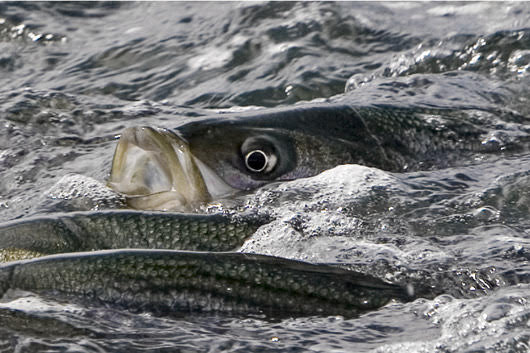STOCK OVERVIEW
All Charts are INTERACTIVE. Please click/tap on the series legend item to add/remove from the chart.
Mobile users, please reorient your device horizantally
* The Spawning Stock Biomass (SSB) Target [252.5 million pounds] is based on 125% of Female SSB Threshold [202 million pounds].
Data Source: Atlantic Striped Bass Benchmark Stock Assessment, 2018
OBSERVATIONS:
Spawning Stock Biomass- In 2017, Striped Bass was determined to be overfished and experienced overfishing relative to the updated reference points (threshold and target).
- Female SSB was estimated at 151 million pounds, below the 202 million pound threshold.
- Total fishing mortality was estimated at 0.307, above the threshold of 0.240.
- Despite recent declines in SSB, the stock is still above the SSB levels observed during the moratorium that was in place in the mid-late 1980s.
- The 2005-2011 period of low recruitment (compared to 1994-2004) contributed to the decline in SSB that the stock has experienced since 2010.
- Recruitment of age-1 fish was high in 2012, 2015, and 2016 (corresponding to strong 2011, 2014, and 2015 year classes), but estimates of age-1 striped bass were below the long-term average in 2013, 2014, and 2017.
- Recruitment in 2017 was estimated at 108.8 million age-1 fish, below the time series average of 140.9 million fish.
Data Source: Atlantic Striped Bass Benchmark Stock Assessment, 2018
Note: toggle series by clicking legend items
OBSERVATIONS:
- Total abundance has waned since its growth in the 1990s to 2004.
- Age 8+ fish have experienced a sharp decline since 2004.
- The disparity between total abundance and age 8+ & SSB is astounding. Toggle the series items to get a feel for yourself.
CATCH AND RELEASE
¹ Includes estimates of Wave 1 harvest for VA and NC from tag releases for years with no MRIP sampling
² 9% release mortality applied to fish released alive
Data Source: Atlantic Striped Bass Benchmark Stock Assessment, 2018
OBSERVATIONS:
As a Percent of Total Removals based on 2017 estimates- Recreational Release Mortality - 48%
- Recreational Harvest - 42%
- Commercial Discards (released dead) - 2%
- Commercial Harvest - 8%
By the numbers, recreational fishing, whether it be catch & release or for-harvest, is vastly more impactful to our Striped Bass fishery than Commercial. This is why it is imperative anglers understand how to mitigate direct-injury fishing, be mindful of environmental risks, and minimize/eliminate their keep rate.
Addressing C&R Fishing Mortality
By understanding the factors that lead to mortality, we can take certain measures to increase the odds of survival. Deep hooking is the number one cause of post-release mortality. This occurs when a fish is able to fully swallow a hook, causing it to be hooked in its internal organs or gills. These fish are up to 6 times more likely to die after being released (Diodati and Richards, 1996). Deep hooking is much more likely to occur with natural bait. New circle hook regulations are designed to decrease the frequency of deep hooking bass. Artificial lures with multiple hooks, treble hooks, and barbs, can still cause damage to fish. Using single hooks without barbs on artificial lures is a great first step to limit damage to fish.
Beyond direct injury fish, the next most important issue is understanding the factors that lead to overstressing fish. These factors are all influenced by environmental conditions. Mortality increases significantly in warmer temperatures and low salinity environments (Bettoli and Osborner, 1995). Higher air temperature also contributes to post release mortality. Special considerations should be given to deciding to fish or how to treat fish on extremely warm days or in locations with lower salinity.
Lengthy fight times can lead to exhaustion as well as a build up of lactic acid, which can cause muscle failure and death (Tiedeman and Danylchuk, 2012).
Please review our Rules and Rec's page for more ways to help save a million bass.
Data Source: Atlantic Striped Bass Benchmark Stock Assessment, 2018
Click on legend items to add/remove series
Data Source: Atlantic Striped Bass Benchmark Stock Assessment, 2018
Click on legend items to add/remove series
F is calculated as an unweighted average of producer and coastal programs’ means
Data Source: Atlantic Striped Bass Benchmark Stock Assessment, 2018
F is calculated as an unweighted average of producer and coastal programs’ means
Data Source: Atlantic Striped Bass Benchmark Stock Assessment, 2018
HARDLINED - F3T Film
HARDLINED, is a 2021 Fly Fishing Film Tour video submission showcasing the urgent care required for Striped Bass restoration across the coast.
"Every year, a migration of epic proportions takes place along the Eastern Seaboard of America. From the Carolinas to Canada, anglers flock to the rocky coastlines, estuaries, rivers and inshore waters to target one of America’s most iconic gamefish- the Striped Bass. Despite its popularity and significance to the coastal communities in the Northeast, the fishery is once again in major jeopardy. The last time this happened, we witnessed one of the greatest conservation success stories of all time, restoring the stock to astronomical numbers. Today, the question on everyone’s mind- can we do it again?"



